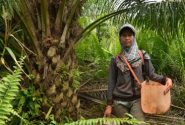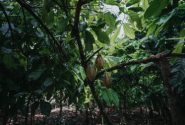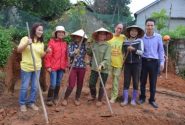BOGOR, Indonesia (21 November, 2012)_If Vietnam wants its timber producers to benefit from the growing eco-conscious and more lucrative international furniture market, national forest institutions should look for ways to get smallholder plantation forests certified, said Louis Putzel, a senior scientist at the Center for International Forestry Research (CIFOR).
Eco-certification may become more important as countries start putting in place import restrictions, with the European Union ruling it will ban illegally harvested wood from entering its market as of March 2013.
However, despite huge national investments in smallholder timber production in the Southeast Asia nation – which has a thriving wooden-furniture industry – the area of certified forests in the country is vanishingly small.
This could make it harder to sell wood to furniture makers, said Putzel, who together with colleagues recently published a study on constraints faced by smallholder timber producers in Vietnam.
“Increasing demand for eco-certified furniture means that Vietnamese factories have to import certified timbers from other countries,” he explained, adding some are now looking as far off as South America for supplies.
“This represents a lost opportunity for local timber planters.”
Vietnam’s Timber and Forestry Product Association estimates wood exports could hit US$4.3 billion this year — a US$400 million jump from 2011. Once heavily subsidized and dominated by state-owned companies, it has benefited recently from steps toward economic liberalisation, transforming the industry into a multi-actor global force.
But it risks being left behind as consumers increasingly go “green.”
Certification schemes, such as those run by the Forest Stewardship Council (FSC) and the Programme for the Endorsement of Forest Certification (PEFC), are intended to help ensure that furniture, paper and other timber-based products have been produced in an environmentally sound and socially responsible manner.
But while this could help local plantation owners in Vietnam earn more money, proving they meet international standards can be expensive, said Ahmad Dermawan, CIFOR scientist and a contributor to the study.
Many small-scale and independent farmers struggle to get by, and may be unable to pay additional funds for audits and documentation.
“Without outside assistance or short-term incentives, farmers with small woodlots probably don’t have the means to apply for and maintain certification,” said Dermawan.
In part because of these obstacles, only five forests in Vietnam today have international certification.
Of these, none are found in the study’s focal province — Binh Dinh, in central western Vietnam — despite it having some 77,000 hectares of designated plantation forest.
Dermawan adds that often when smallholders need to get their hands on fast cash — for emergencies, for instance — they harvest trees early for sale into the regional woodchip market.
As such, timber quality in Binh Dinh is generally poor, he said.
For the province’s furniture sector, this creates sourcing problems, currently being by-passed with purchases of certified raw timber from overseas — sometimes from as far away as Brazil and Costa Rica.
Only 20 percent of wood processed in Binh Dinh for export originated in Vietnam in 2007, of which less than half came from plantations in the province, Putzel said.
This not only puts domestic growers at a competitive disadvantage (FSC labeled sales were estimated at over US$20 billion in 2010), but is also a surprise considering recent government efforts to encourage plantation forestry.
Policies such as the “Five Million Hectare Reforestation Program” helped boost planted forests by 260 percent between 1990 and 2010, according to Putzel. In addition, the state actively promotes smallholder plantations by allocating land to local households and providing seedlings to communities.
Although smallholder forest management in Vietnam remains problematic on many levels, with a focus on only a couple of species of timber and inadequate inputs to raise productivity, smallholder farmers could benefit in the long term from specially designed schemes, such as the FSC’s Small and Low Intensity Managed Forests (SLIMF) initiative.
With some initial external support, tree farmers could benefit in several ways, Putzel said. SLIMF entails lower costs for members and brings increased potential to share information so they can keep their certification up-to-date. They are also in better positions to negotiate prices and market their products.
In recent years, CIFOR helped fund Improved Certification Schemes for Sustainable Tropical Forest Management, a project that led to the development of national standards for “small and low intensity” initiatives in Cameroon, Mexico and Brazil.
The project worked with smallholders and communities to help develop tools and incentives to protect biodiversity, as well as remove barriers to certification for the tropical forests they managed.
Now, organisations are developing a variety of group schemes for smallholders, including one by FSC and Fairtrade International which are piloting projects that provide help with dual labeling.
“Only time will tell if they will work,” said Putzel. “However, for those interested in tipping the balance in favor of small local producers, community origin labeling and combined Fairtrade and eco-certification are intriguing concepts.”
In the meantime, the authors hope that valuable lessons will be learned from a recent SLIMF certification project: The Quang Tri Smallholder Forest Certification Group (FCG). Located in nearby Quang Tri province, the group got globally certified in 2010. Although it benefited early on from external support, including through World Wildlife Fund-subsidized certification costs, Putzel is eager to see if the project will be successful.
“If it is,” he said, “there are potentially other areas of Vietnam, including Binh Dinh province, where it could work, because smallholder forestry has been widely promoted.”
“Still, a lot of additional research needs to be done, including on whether the species chosen for planting by smallholders—which are usually exotic species planted in mono-cultural and even-age stands—are ecologically suitable.”
This work is part of a project funded by the German Federal Ministry of Economic Cooperation and Development (BMZ) and forms part of the CGIAR Program on Forests, Trees and Agroforestry.
We want you to share Forests News content, which is licensed under Creative Commons Attribution-NonCommercial-ShareAlike 4.0 International (CC BY-NC-SA 4.0). This means you are free to redistribute our material for non-commercial purposes. All we ask is that you give Forests News appropriate credit and link to the original Forests News content, indicate if changes were made, and distribute your contributions under the same Creative Commons license. You must notify Forests News if you repost, reprint or reuse our materials by contacting forestsnews@cifor-icraf.org.
Further reading
Chopping for chips: An analysis of wood flows from smallholder plantations in Vietnam
Financing household tree plantations in Vietnam: Current programmes and future options
Forest certification and communities: Looking forward to the next decade
Smallholder timber plantation development in Indonesia: what is preventing progress?













